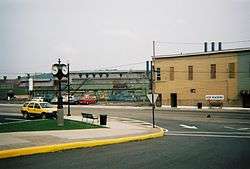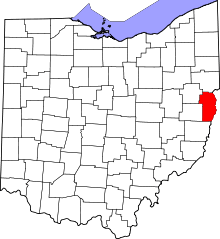Mingo Junction, Ohio
| Mingo Junction, Ohio | |
|---|---|
| Village | |
|
Downtown Mingo Junction | |
| Nickname(s): "Little Vegas" | |
| Motto: "No Place Like The Junction" | |
 Location of Mingo Junction, Ohio | |
 Location of Mingo Junction in Jefferson County | |
| Coordinates: 40°19′12″N 80°36′44″W / 40.32000°N 80.61222°WCoordinates: 40°19′12″N 80°36′44″W / 40.32000°N 80.61222°W | |
| Country | United States |
| State | Ohio |
| County | Jefferson |
| Township | Steubenville |
| Government | |
| • Type | Mayor-Council |
| • Mayor | Hut Rouse (D) |
| Area[1] | |
| • Total | 2.86 sq mi (7.41 km2) |
| • Land | 2.69 sq mi (6.97 km2) |
| • Water | 0.17 sq mi (0.44 km2) |
| Elevation[2] | 797 ft (243 m) |
| Population (2010)[3] | |
| • Total | 3,454 |
| • Estimate (2012[4]) | 3,380 |
| • Density | 1,284.0/sq mi (495.8/km2) |
| Time zone | Eastern (EST) (UTC-5) |
| • Summer (DST) | EDT (UTC-4) |
| ZIP code | 43938 |
| Area code(s) | 740 |
| FIPS code | 39-50904[5] |
| GNIS feature ID | 1065035[2] |
Mingo Junction is a village in Jefferson County, Ohio, United States, along the Ohio River. Mingo Junction is part of the Weirton-Steubenville, WV-OH Metropolitan Statistical Area. The population was 3,454 at the 2010 census.
Geography
Mingo Junction is located at 40°19′12″N 80°36′44″W / 40.32000°N 80.61222°W (40.319869, -80.612240).[6] It is in the Eastern time zone, and the average elevation is 797 ft. According to the United States Census Bureau, the village has a total area of 2.86 square miles (7.41 km2), of which 2.69 square miles (6.97 km2) is land and 0.17 square miles (0.44 km2) is water.[1]
History
The Mingo Indian tribe once had a settlement at the location of the present day village, which is the source of its name. Originally known as Mingo Bottom or Mingo Town, it was the starting point for the ill-fated Crawford expedition against hostile Indians in 1782, during the American Revolutionary War.
Mingo Junction was founded circa 1869 when an iron works was started there.[7]
The population was 3,454 at the 2010 census. In 1900, its only manufacturing plant was a steel mill owned by Carnegie Steel Company. Past population figures are: 1900, 2,954; 1910, 4,049; 1940, 5,192.
Neighborhoods
Altamont Hill, Churchill, Hillsboro, Hunky Hill, North Hill, Sunrise Terrace Downtown, and Goulds
Demographics
| Historical population | |||
|---|---|---|---|
| Census | Pop. | %± | |
| 1880 | 371 | — | |
| 1890 | 1,856 | 400.3% | |
| 1900 | 2,954 | 59.2% | |
| 1910 | 4,049 | 37.1% | |
| 1920 | 4,616 | 14.0% | |
| 1930 | 5,030 | 9.0% | |
| 1940 | 5,192 | 3.2% | |
| 1950 | 4,464 | −14.0% | |
| 1960 | 4,987 | 11.7% | |
| 1970 | 5,278 | 5.8% | |
| 1980 | 4,834 | −8.4% | |
| 1990 | 4,297 | −11.1% | |
| 2000 | 3,631 | −15.5% | |
| 2010 | 3,454 | −4.9% | |
| Est. 2015 | 3,324 | [8] | −3.8% |
2010 census
As of the census[3] of 2010, there were 3,454 people, 1,488 households, and 948 families residing in the village. The population density was 1,284.0 inhabitants per square mile (495.8/km2). There were 1,675 housing units at an average density of 622.7 per square mile (240.4/km2). The racial makeup of the village was 94.5% White, 3.6% African American, 0.3% Native American, 0.1% Asian, 0.1% from other races, and 1.4% from two or more races. Hispanic or Latino of any race were 0.8% of the population.
There were 1,488 households of which 26.7% had children under the age of 18 living with them, 44.0% were married couples living together, 14.3% had a female householder with no husband present, 5.4% had a male householder with no wife present, and 36.3% were non-families. 31.6% of all households were made up of individuals and 16.1% had someone living alone who was 65 years of age or older. The average household size was 2.32 and the average family size was 2.89.
The median age in the village was 44.2 years. 21.1% of residents were under the age of 18; 8.6% were between the ages of 18 and 24; 21.4% were from 25 to 44; 29% were from 45 to 64; and 19.9% were 65 years of age or older. The gender makeup of the village was 47.5% male and 52.5% female.
2000 census
As of the census[5] of 2000, there were 3,631 people, 1,542 households, and 1,062 families residing in the village. The population density was 1,430.7 people per square mile (551.9/km²). There were 1,691 housing units at an average density of 666.3 per square mile (257.0/km²). The racial makeup of the village was 95.35% White, 3.00% African American, 0.17% Native American, 0.03% Asian, 0.11% Pacific Islander, 0.39% from other races, and 0.96% from two or more races. Hispanic or Latino of any race were 0.77% of the population.
There were 1,542 households out of which 25.6% had children under the age of 18 living with them, 51.8% were married couples living together, 12.9% had a female householder with no husband present, and 31.1% were non-families. 27.6% of all households were made up of individuals and 15.0% had someone living alone who was 65 years of age or older. The average household size was 2.35 and the average family size was 2.84.
In the village the population was spread out with 21.1% under the age of 18, 6.5% from 18 to 24, 25.6% from 25 to 44, 26.8% from 45 to 64, and 20.0% who were 65 years of age or older. The median age was 43 years. For every 100 females there were 87.7 males. For every 100 females age 18 and over, there were 84.8 males.
The median income for a household in the village was $30,196, and the median income for a family was $40,326. Males had a median income of $37,969 versus $20,809 for females. The per capita income for the village was $16,062. About 10.8% of families and 12.8% of the population were below the poverty line, including 19.0% of those under age 18 and 8.1% of those age 65 or over.
Education
Public education in the village of Mingo Junction is provided by the Indian Creek Local School District. Campuses serving the village include Hills Elementary School (Preschool-Grade 4), Indian Creek Middle School (Grades 5-8), and Indian Creek High School (Grades 9-12). Jefferson County Christian School was also located in the area until 2012. Until 2009, the Catholic school of St. Agnes (Pre-kindergarten to eighth grade) was part of the Steubenville Parochial School District.
Notable people
- Andrea DeShong, former female boxer
- Lloyd "Spud" Hughes, inventor of the Menthol cigarette
- Woody Hayes, longtime Ohio State University football coach
- Joe Fortunato, professional football player for the Chicago Bears
- Robert Parissi, lead singer of Wild Cherry
Usage in film
Mingo Junction served as the Pennsylvania steel mill town in the 1978 film The Deer Hunter, which won the Academy Award for Best Picture and starred Robert De Niro, Meryl Streep, Christopher Walken, and John Cazale. Many of the scenes that took place in and around a steel mill were filmed in Mingo Junction. Mingo was also the primary filming location for Reckless, which was released in 1984. Cast members included Aidan Quinn and Daryl Hannah. Many scenes were set in Mingo Junction or nearby cities such as Pittsburgh, Steubenville, Ohio, and Weirton, West Virginia. Movie credentials also include 1983's "All the Right Moves" starring Tom Cruise and Craig T. Nelson and Heart of Steel with Peter Strauss and Pamela Reed, also of 1983. The 1979 film Take Down, starring Lorenzo Lamas and Kevin Hooks, was set at Mingo Junction High School.
In 2016 the village is visited and filmed in dutch television show called "Jensen kiest voor Amerika" (Jensen chooses for America).
See also
References
- 1 2 "US Gazetteer files 2010". United States Census Bureau. Retrieved 2013-01-06.
- 1 2 "US Board on Geographic Names". United States Geological Survey. 2007-10-25. Retrieved 2008-01-31.
- 1 2 "American FactFinder". United States Census Bureau. Retrieved 2013-01-06.
- ↑ "Population Estimates". United States Census Bureau. Retrieved 2013-06-17.
- 1 2 "American FactFinder". United States Census Bureau. Retrieved 2008-01-31.
- ↑ "US Gazetteer files: 2010, 2000, and 1990". United States Census Bureau. 2011-02-12. Retrieved 2011-04-23.
- ↑ Doyle, Joseph Beatty (1910). 20th Century History of Steubenville and Jefferson County, Ohio and Representative Citizens. Richmond-Arnold Publishing Company. p. 444.
- ↑ "Annual Estimates of the Resident Population for Incorporated Places: April 1, 2010 to July 1, 2015". Retrieved July 2, 2016.
- ↑ "Census of Population and Housing". Census.gov. Retrieved June 4, 2015.

